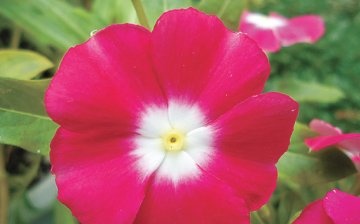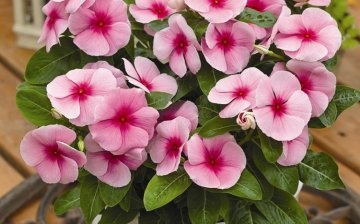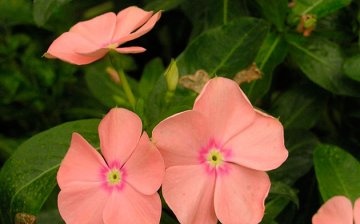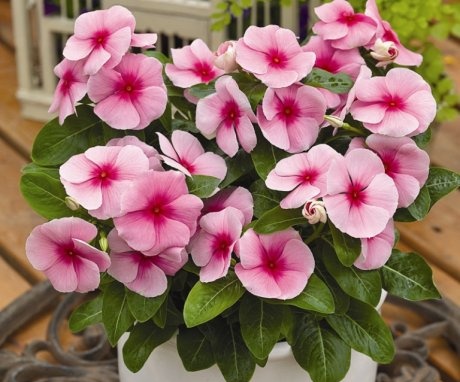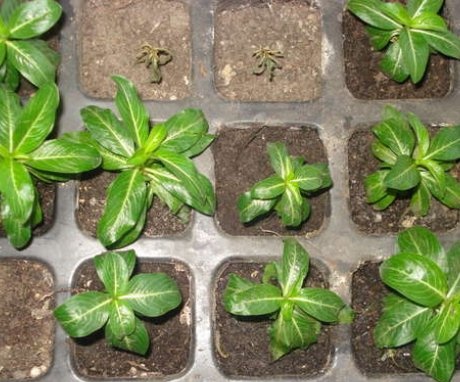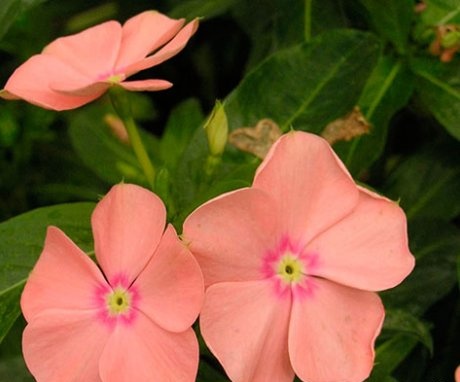Catharanthus flower: growing in the garden and on the windowsill
Catharanthus is often referred to as "Pink Periwinkle" or "Cayenne Jasmine". It began its distribution from the islands of Madagascar, but is also often found in Indonesian, Chinese, Indian and Philippine countries. In a wild subtropical climate, the plant can reach one and a half meters in height, and when grown at home, it barely exceeds half a meter.
Today, catharanthus is often used as an annual plant for garden decoration and is rarely found in an apartment or house. But flower growers claim that the plant is unpretentious and can decorate the interior with rich colors for years.
Content:
- The appearance of the catharanthus and its types
- How to ensure optimal growing conditions
- Reproduction methods and flower planting technology
- How to provide proper plant care
- Disease and pest control
The appearance of the catharanthus and its types
Catharanthus outwardly resemble phloxes, but grows much lower and its flowers do not have such a pronounced odor. The advantage of the catharanthus is the large bright pink flowers, the corollas of which are painted in a purple hue. The inflorescence consists of five separate petals. Over time, breeders have developed hybrid plant varieties that have brought variety to the color range of this crop.
Today you can find catharanthus with purple, blue, purple and white flowers, which are concentrated on the tips of the shoots in several pieces.
The shoots of the flower are flexible and are covered with a thin green bark - in young shoots and brown - in tall stems. Leaves of rich emerald color, oval-pointed shape. They are attached to the shoots with short petioles. The leaves of some varieties are decorated with white veins. After flowering, seed leaflets are formed on the catharanthus, in which small seeds ripen.
In home gardening, you can find catharanthus of various types and varieties.
- "Pusillus" or miniature periwinkle is an annual flower with erect shoots, growing up to 20 cm. It blooms in July or August with white flowers 7-9 cm in diameter. After flowering, decorative pods with seeds are formed.
- Catharanthus roseus is popular in indoor floriculture. It is a perennial that, with proper care, turns into a lush ornamental bush. The crown is formed by spreading twigs covered with smooth glossy leaves. It blooms with simple flowers of all shades of pink. If the plant feels comfortable, then it pleases its owner with color from late spring to early autumn.
This species has several hybrid varieties of groups.
"Pacific" - includes varieties:
- "Burgundy" - with burgundy-red flowers, crowned with a white eye.
- "White" - with flowers of a snow-white color.
- "Epricot" - blooms with creamy flowers with a raspberry center.
- Ice-Pink is the owner of soft pink flowers.
"Cooler" - combines varieties:
- "Grape" - blooms with lilac flowers with a pink eye.
- "Pepermint" is the owner of snow-white flowers with a red center.
- "Red" - with bright scarlet flowers.
- "Fest Kiss" - varieties of this group are distinguished by their large size and extraordinary colors, among which the most popular is "Blueberry", which blooms with velvet purple-blue flowers.
- "Albus" - bushes grow up to 25 cm, whitish veins are clearly visible on large matte leaves. It blooms with white flowers with a yellow center.
- "All America Selections" - blooms with blue flowers with a purple tint.
- "Cascade" - the variety is intended for planting in hanging flowerpots. Shoots of this catharanthus can grow up to one and a half meters in length, cascading down to the ground. It blooms with flowers of various shades.
In addition to its decorative qualities, the flower has pronounced healing properties and is widely used in folk medicine at home, including as an antitumor agent.
How to ensure optimal growing conditions
Catharanthus cannot be called a demanding plant, its cultivation does not take much effort and does not require special skills. It is important to create conditions close to natural, and the flower will feel comfortable:
- Lighting should be abundant, but not directly exposed to sunlight. It is optimal to place the catharanthus on the southeast or southwest side. After the winter rest, the flower is gradually taught to light, otherwise it can get sunburn. And if artificial lighting is organized in winter, then it can bloom almost all year.
- The temperature regime in summer should be in the range from 21 to 28 degrees, and in winter from 16 to 19 degrees. It is important that the soil in the flowerpot does not overcool during wintering.
- Airing. Catharanthus will not live in stuffy rooms. Therefore, ventilation should be provided regularly, and in the warm season, the flower should be taken out into fresh air.
- Humidity is an important component of the conditions of detention. The plant needs daily spraying, and in the summer it is advisable to place flowerpots on trays with moistened moss or pebbles.
If flowers are planted in flower beds, then you need to choose a well-lit open place, but protect from direct sun. The planting site must have good drainage to avoid stagnant water, which negatively affects the health of the plant.
Reproduction methods and flower planting technology
Even inexperienced flower growers can grow catharanthus. It is enough to adhere to the rules of reproduction and planting and after a while you can get a young flowering plant. Catharanthus are distinguished by their rapid growth rates and in order for the flowers to develop normally, they need to be planted in spacious clay or ceramic flowerpots.
Plants prefer light, salt-free nutrient soils, for the preparation of which they take equal parts of sod, humus and leafy soil, peat and sand. When buying a soil mixture, you should choose a soil for geraniums.
Reproduction of the catharanthus can be carried out in three ways: by dividing the bush, using cuttings and sowing seeds.
Dividing the bush... It is used in the presence of mature, well-developed bushes that need to be transplanted. The procedure is carried out in the spring. An adult plant is carefully dug up, the roots are freed from the soil and divided into several parts. Plots take root well and can be planted both in pots and flower beds.
Cuttings... According to experienced florists, catharanthus should not be kept for more than three years. The plant grows rapidly, which affects its decorative effect and quality of flowering.:
- cuttings are cut from the apical shoots
- the cut parts are placed in a container with water, in which it is recommended to add a growth stimulant
- when roots appear, the plant can be planted in prepared soil
- also cuttings root well in wet sand
- to accelerate the rooting process, you need to maintain a temperature of at least twenty degrees
- after planting the cuttings, they need to create greenhouse conditions by covering with a jar or plastic. It is also necessary to provide regular ventilation.
Catharanthus are often grown from seeds, this process is carried out according to the standard scheme:
- sowing can be carried out all year round
- purchased or collected seed is treated with a manganese solution to destroy pathogens. After the procedure, the seeds must be dried.
- the prepared seed material is deepened into the moistened soil by 1-1.5 cm
- crops are covered with opaque polyethylene or sent to a dark place
- the temperature should be kept at least 23 degrees
If everything is done correctly, the seeds will sprout in a week. Seedlings need to be watered regularly, and after 14-21 days, the first feeding should be carried out. When two pairs of leaves are formed on the seedlings, they are planted in individual containers.
Landing rules:
- It is necessary to plant catharanthus in well-loosened soil. You should also add expanded clay or fine gravel to the soil. Planting holes are preliminarily prepared, the bottom of which is covered with a drainage layer.
- Part of the prepared earth is poured onto the drainage layer. Seedlings, rooted cuttings or plots are installed in the holes, the roots are straightened and covered with the remaining soil. The soil needs to be tamped and watered, a layer of mulch can be laid on top.
When working with catharanthus, remember that this is a poisonous plant. Therefore, you need to protect your hands with gloves. Also, you should not place plants in a place accessible to children and pets.
How to provide proper plant care
For the successful development of a catharanthus, it is enough to provide optimal growing conditions and provide competent care, which consists of standard actions:
- Irrigation. The flower loves water, but does not tolerate its stagnation. Therefore, you need to water the plant abundantly throughout the year. Do not allow the earthen coma to dry out and remove excess liquid from the pallet. When growing a catharanthus in a flower bed, plantings should not be made thick. This helps the plants survive the rainy season, during which they stop developing.
- Top dressing. The rapid growth of the plant contributes to the rapid depletion of the soil, so fertilization should be applied every one and a half weeks. The first time the flowers are fed at the beginning of flowering. Mineral dressing you need to alternate with organic, and also add humus or humus to the soil. If the catharanthus is grown in an apartment, then feeding is carried out throughout the year.
- Transfer. Due to the rapid growth, the catharanthus needs to be regularly transplanted into larger containers. Transplants are carried out annually in the spring. Before the procedure, you need to trim the shoots by a third of their length.
- Pruning. Young plants are pruned or pinched off the shoots. This is necessary to stimulate branching and the formation of a fluffy ornamental bush. Also, such activities increase the number of buds that form on young branches.
When growing catharanthus in pots or flowerpots, the plants are planted three in one container. To prevent excessive thickening, you need to cut out damaged branches and those that grow deeper into the crown. This method of planting helps to increase decorativeness due to different colors of flowers, if different varieties of catharanthus are planted in one pot.
Disease and pest control
Catharanthus have strong immunity to diseases and pests. But with inadequate care, they can be affected by fungal infections, spider mites and scale insects:
- fungi attack the leaves and stems when the plant is waterlogged. Appear with brown spots
- scale insects and mites attack the flower with insufficient moisture
- lack of lighting leads to stretching of shoots
- lack of trace elements slows down the growth of the flower
- low air humidity leads to dry leaf tips
- lack of light leads to shedding of buds
You can fight fungi and harmful insects with the help of special chemicals or spray with a kerosene talker with the addition of oil and alcohol.
Katarantus is often used by landscape designers. The plant is appreciated for its decorative appearance and ease of growing. In flower beds, the flower grows like an annual, and in apartment conditions it pleases the owners for more than one year. Catharanthus looks spectacular in combination with petunias and balsam. To achieve the desired decorative look. You need to take care of the plant with love, because it reacts sharply to negative emotions.
More information can be found in the video:



